For most people, a French landscape is also a formal landscape, and therein lies its appeal.
Think Versailles, probably the most well-known French garden space. It has a distinct look and feel that set it apart from its Italian neighbors to the south and its British neighbors to the north. Still, there are elements of both. What we think of as traditional French style does have its roots in Italian landscape design. The resulting French adaptation was in turn adopted by British gardeners, and their adaptations made their way back across the Channel and in turn influenced later developments.
Symmetry and order are the heart of French landscape design. The gardens are also meant to be viewed from a distance, so form and design play a major role. They’re meant to highlight the centerpiece of the entire space, which would be the house (or, in most cases, the chateau). They’re known for their cool color palette, with an emphasis on whites, greens, blues and purples. Think boxwood hedges, intricately clipped shrubs, neatly planted garden beds and planters, and fields of lavender. You’ll also find a great use of stone, whether for pavings, edgings, a terrace or decorative elements, and places where you can enjoy the view.
Versions for Country and CourtyardFrench country gardens are more informal, with a mix of softer plantings and bolder colors, but generally follow the same basic design principles. Planting beds may be more loosely planted and less structured, but they’ll still be contained by an edging or a border of some sort. The same gravel beds that work in a formal space fit in just as well in a small home’s front entryway. Rather than an overwhelming riot of color and plantings, there’s always a sense of order, even in the most natural of settings.
Although we often think of French landscaping in terms of large spaces, the overall style translates remarkably well into smaller courtyards (imagine an interior garden in a Paris building) and even the practical vegetable garden, where a mix of small raised beds is not only popular but practical. So while you might not want an entire landscape done in this style, you might find it ideal for a smaller area of your garden.
Warning: A formal design requires far more maintenance than, say, a natural garden. When something is out of place, it’s immediately obvious. If you don’t want to spend a lot of time keeping your garden in shape, a formal French-style estate may not be for you.
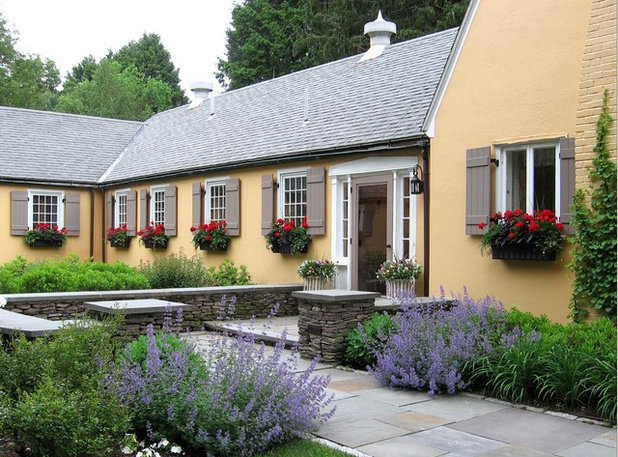
Woodburn & Company Landscape Architecture, LLC
Start with the basics. Meaning stucco walls, stonework and, of course, lavender. The window boxes add a touch of bright color to contrast with the soft greens, purples and whites found in the rest of this tidy landscape.
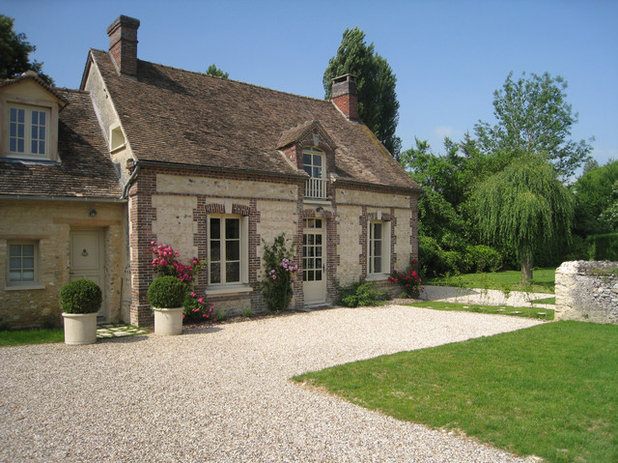
A+B KASHA Designs
You can't get much more French than this home in the Normandy countryside. The overall design is simple, featuring the strong, straight lines and neatly kept gardens that exemplify French style.

Isler Homes
This small courtyard epitomizes the essence of French design, especially when viewed from above. All of the basics are here: striaght-lined geometric shapes, neatly trimmed hedges and shrubs, gravel for paving and a monochromatic color scheme.
Design tip: In even the most formal of gardens, it's great to include one thing that doesn't quite fit the mold. In this landscape, the bench provides a one-of-a-kind element in the otherwise repetitive (in the best gardening sense) space, keeping it from seeming too sterile.
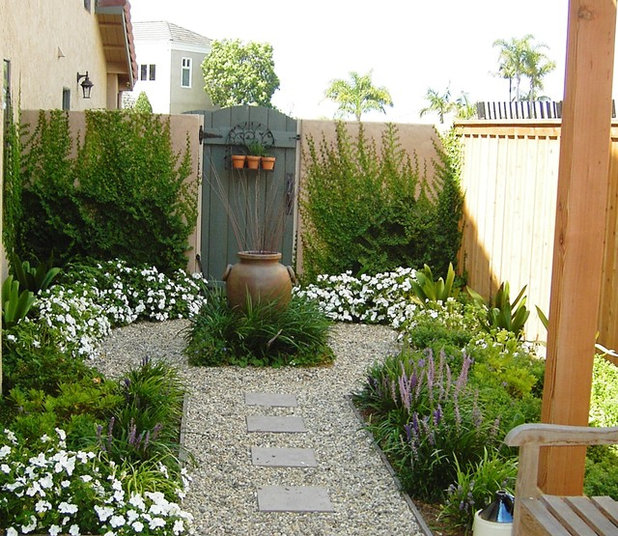
debora carl landscape design
Stone surfaces provide the underpinnings. Gravel paths and stone terraces are hallmarks of French garden design. A gravel path is one of the easiest ways to start your landscape. In this case, the gravel defines the path area, while the inset stepping-stones make for a more stable walking surface.
Design tip: With any loose stone, be prepared for some maintenance. While landscape and weed-barrier cloths will keep weed growth down, nothing is foolproof. You will need to periodically remove unwanted plant material. The secret is to do it before things get out of control.
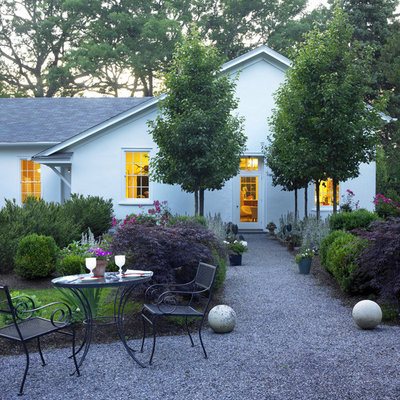
Expand a gravel path into a patio to provide continuity. This simple bistro set adds to the feel, as do the trees along the path that form a small allée
. The matching spheres add a bit of a formal look while delineating the transition from path to patio.
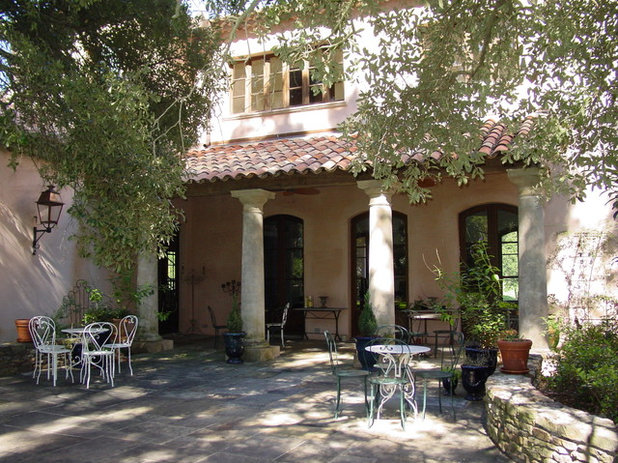
Al Jones Architect
For a more durable surface, consider flagstone or cobblestone. Edge the space with planting beds and add pots and climbers to soften the hardscape.
Design tip: Using low stone walls to form planting beds not only elevates the plants and provides more growing space, but it's also a great way to add extra seating. Choose a stone that complements the pavers on the patio so the entire space is cohesive.
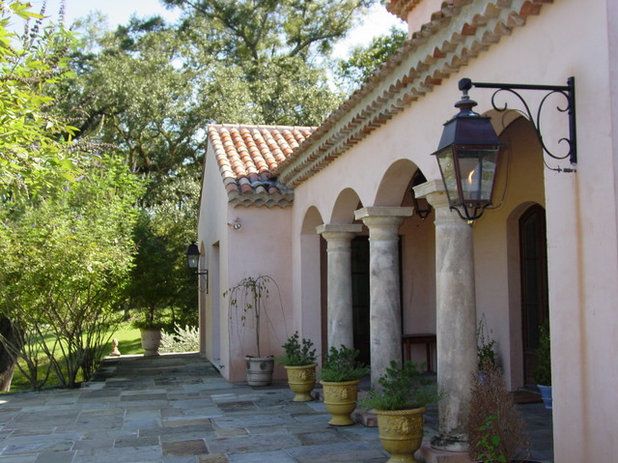
Al Jones Architect
This Provence-inspired terrace highlights the overall simplicity of French terrace design — clean, simple and restful. A nice touch is the matching pots at the bottom of each column. They add some color and life to the terrace.
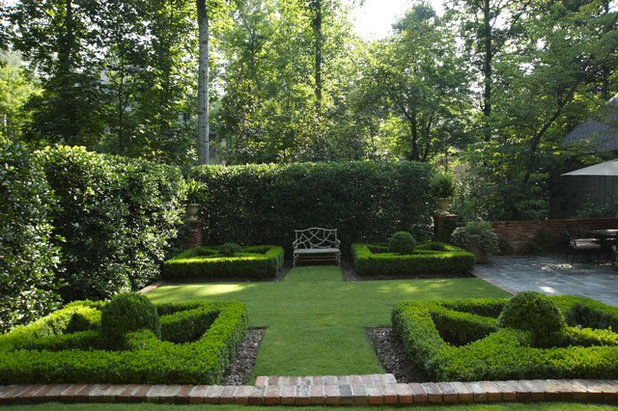
Troy Rhone Garden Design
Design the planting beds. French style is a study in geometry. Decide on the shapes you want for the planting beds, then make sure they're clearly defined. Edging these traditional parterres with low boxwood borders is a classic approach.
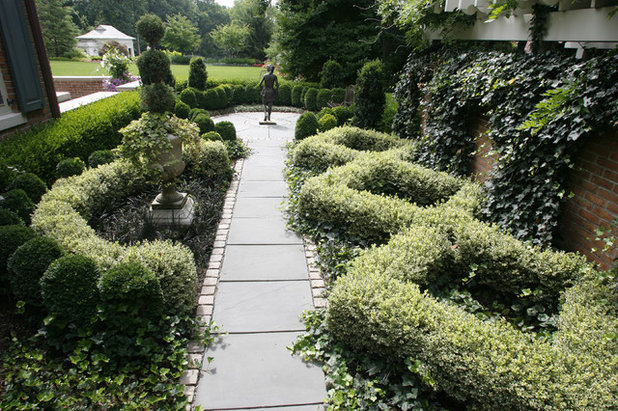
The Todd Group
Fell free to mix and match when it comes to shapes. The diamonds on the right are offset by the semicircle on the left. Using the same plant material to form the shapes ties the two sides together.
Design tip: Be sure to look at the space from all levels. It should be pleasant when you're in the midst of the garden, but it should also be visually interesting to look into the garden from outside or to view it from above.
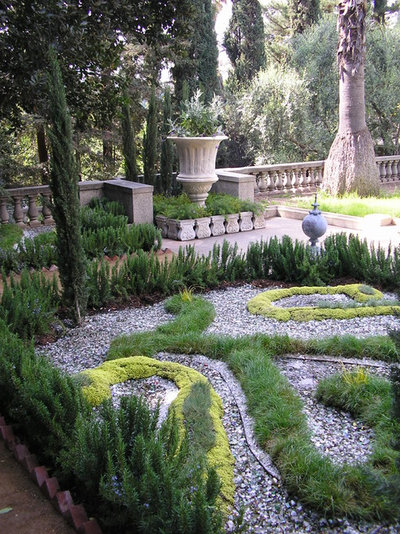
Cassy Aoyagi, FormLA Landscaping
While straight lines and hard edges are often seen as typically French, a more free-form knot garden wouldn't be out of place either. This one was designed as a strolling garden, a place of peacefulness and reflection.
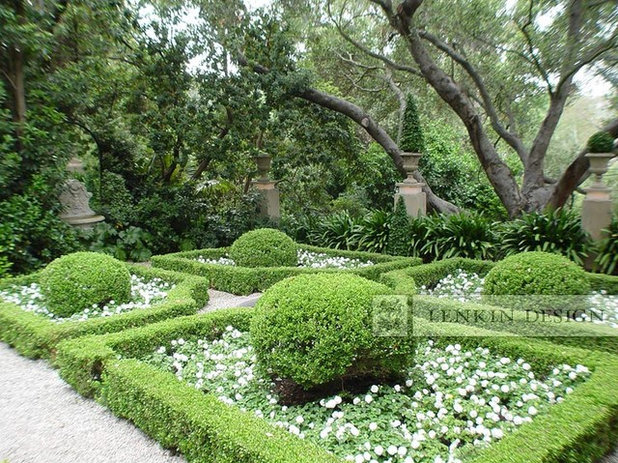
Lenkin Design Inc: Landscape and Garden Design
Add plants. Fill the spaces within the borders with plants, especially annuals and perennials. For a classic feel, stick to a single plant within each space, as was done here. The topiary-inspired balls that punctuate each bed add some height without distracting from the cool, clean overall look and feel.
Design tip: When choosing plantings, consider their bloom period. A bed of tulips will look charming in the spring, but you'll need something in the space for summer through fall at the very least. Also consider the care requirements; if the bed is fairly wide and tightly packed, it can be difficult to reach the interior plants for deadheading and other maintenance.
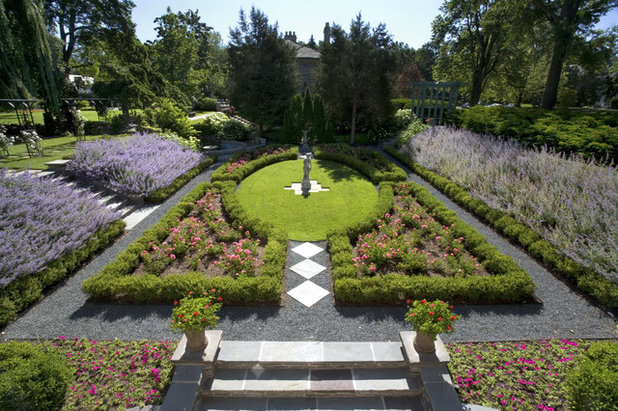
Schmechtig Landscapes
Mix and match within the overall space. The plantings within each bed here are uniform, but they vary from bed to bed.
Design tip: Creating a focal point, such as this fountain set in a semicircle of green, adds needed interest, especially in a large space where the masses of similar beds could be overwhelming. In this space, which is very large, the bed and trees also serve as similar breaks but don't overwhelm the design. In a smaller space, go with just one focal point.
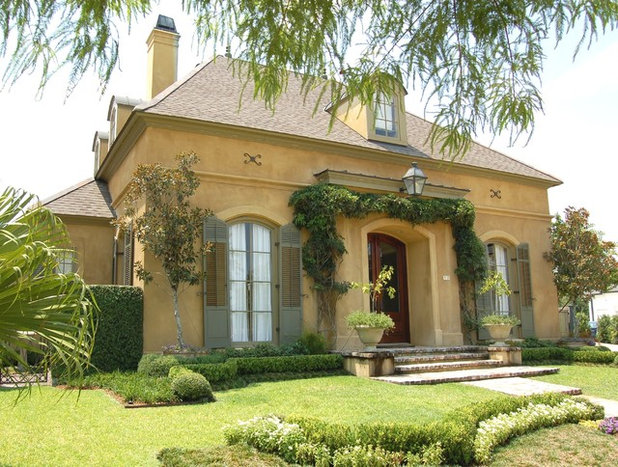
Daly-Sublette Landscape Architects
Away from the formal beds, add some climbers for dimension and to frame a view. In this case, the view is the front door; the arching wisteria, which is a vibrant purple against the soft yellow walls when in bloom, accentuates the height of the door and the matching windows on either side.
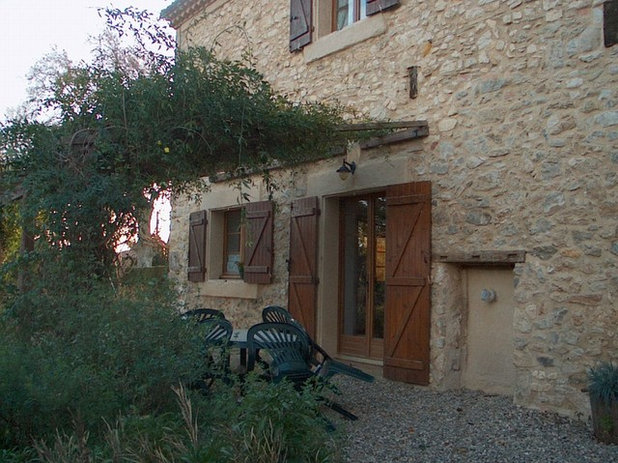
Rebekah Zaveloff | KitchenLab
A little more casual is this vine covering a patio space. Look for a plant that will provide shade through most of the outdoor season. Your personal style will dictate if you want greenery only or some color provided by flowers. If you choose the latter, be sure the blooms are more subdued than exuberant for a classic French feel.
Another good choice is an espaliered fruit tree. Edibles were always part of a French garden, and a well-trained espaliered tree will fit right in.
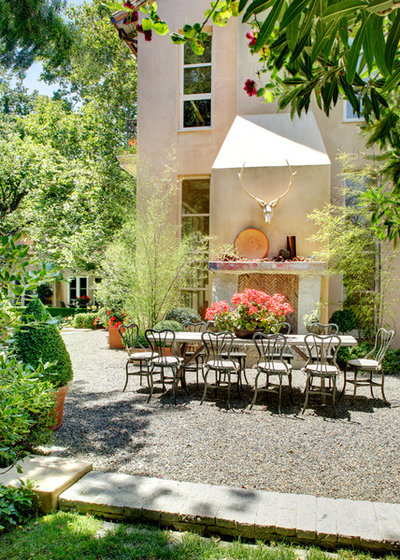
Dave Adams Photography
Include a place to relax and eat. Sitting areas and dining spots add a touch of romance and evoke the feeling of the French countryside. Keep the elements simple, with low-profile furniture (think bistro set rather than massive wood tables) and an open-air ceiling.
Design tip: While an eating area near the house is convenient, consider moving it slightly away, into another spot in the landscape. You'll discover a whole new view of your garden.
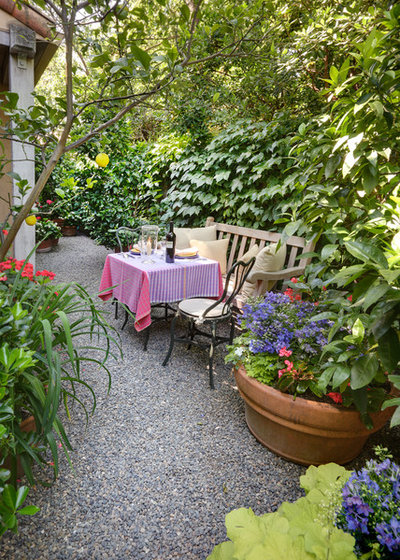
Dave Adams Photography
While this small yard is casual and colorful, it's still very French. In a small space, adding color through flowers and linens gives a country feel that's equally as inviting as that of the previous space.

Dave Adams Photography
Though perhaps more filled with furniture than is typical for a patio space, French elements still shine through here, with the open terrace, stonework and hedge defining the space. The symmetry of the plants also keeps the French-inspired feel.
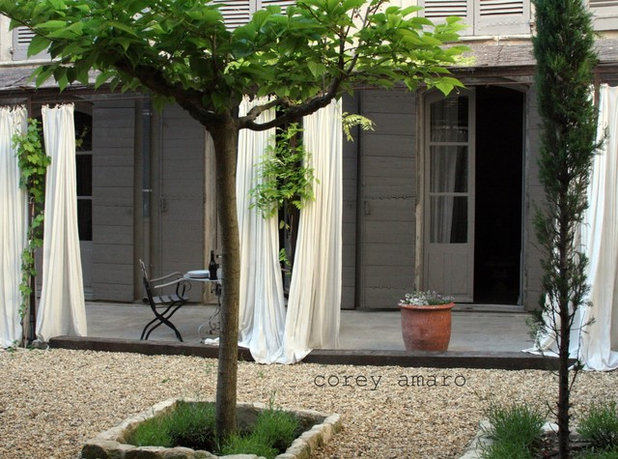
Tongue in Cheek Antiques
This courtyard combines traditional and contemporary elements. The curtains add a nice touch, softening an otherwise stark space.
Design tip: Patios, terraces and courtyards are ideal locations for potted plants. To keep the look consistent, match the color, style and materials of the containers, and don't overcrowd them. Use them as focal points or place them at equal intervals throughout the space. Repeating the color or type of plant will also keep the look cohesive.
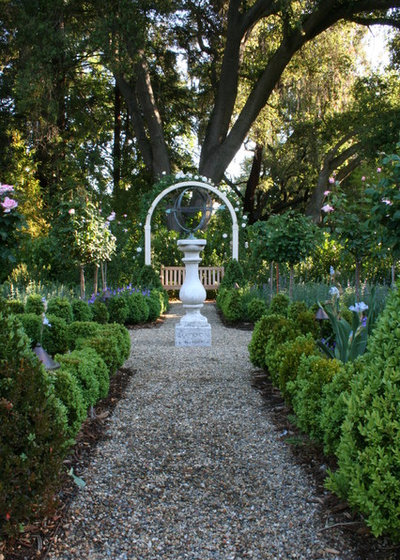
Frank & Grossman Landscape Contractors, Inc.
Use decorative elements. Statues, urns and planters, and water features are all elements of French garden design. The key is restraint. A simple fixture at the end of a gravel path is all you need as a focal point.
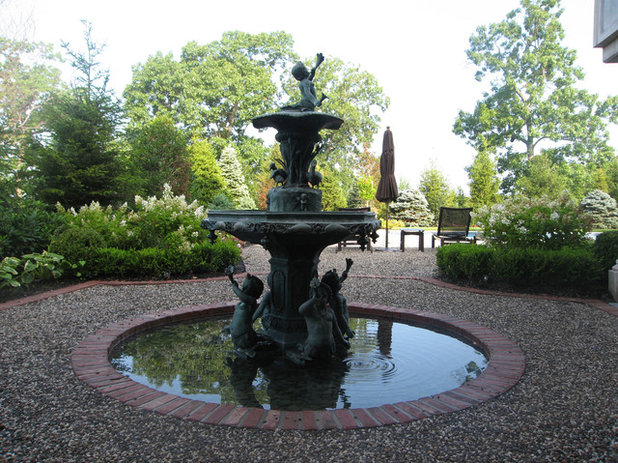
edgewater design llc
Combining both water and statuary is another way to go. Whether you set them in stone or in a garden, keep the space around them simple so the featured element shines.
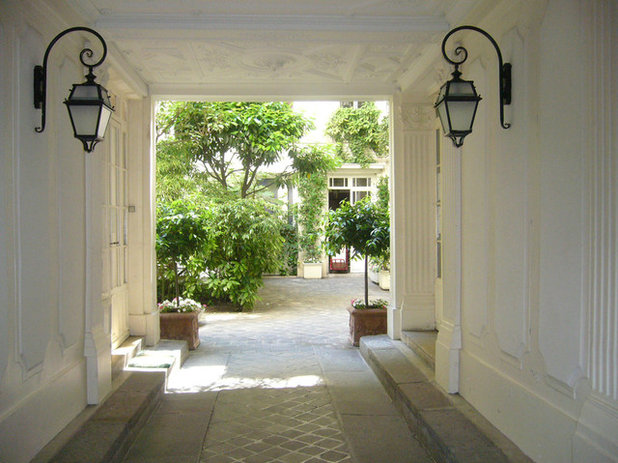
A+B KASHA Designs
Courtyards and potagers. This interior space, a long passage(with symmetrically placed lighting and planters, leads to a plant-filled courtyard that still retains a sense of openness, thanks to the single color palatte and the low-key gravel paving.
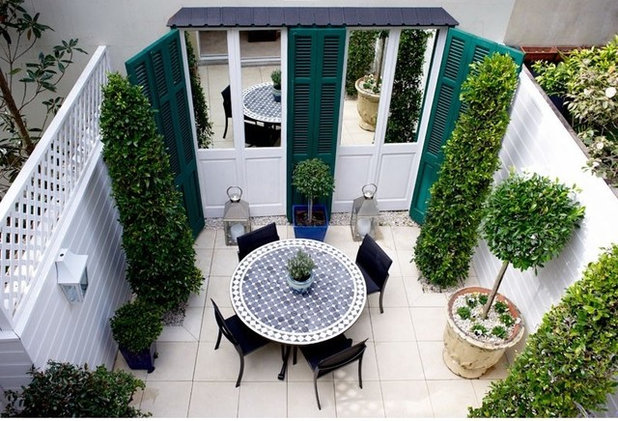
The Labyrinth Garden
Simple French-inspired design, along with strategically placed mirrors, helps open up an even smaller space. Again, a simple color palette and low-key furniture combined with the formal plant shapes and less-is-more approach exemplifies French design.
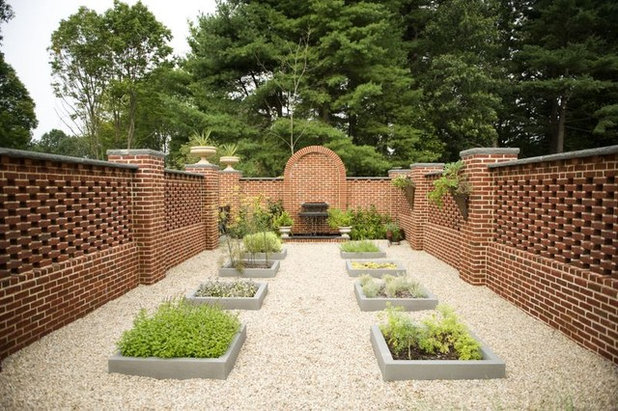
Natalie DeNormandie
While vegetables may be the last thing you'd expect in the formality of a traditional French garden, don't overlook them completely. Potagers and herb gardens were staples of design. Here, the classical influence is seen in the high walls, the gravel path and the wood-edged parterres.
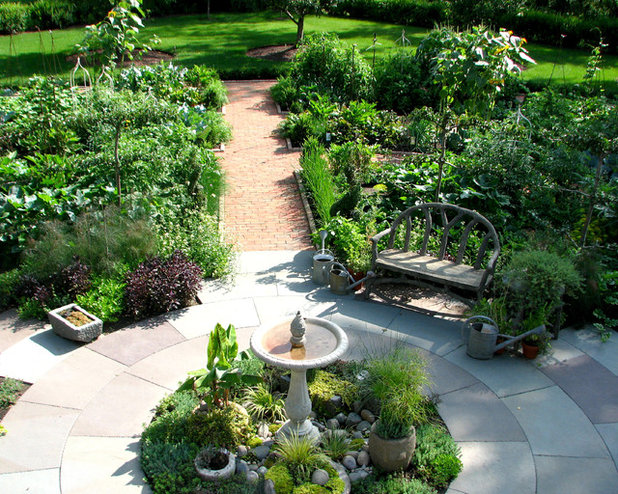
The Brickman Group, Ltd.
This potager is more full and lush than the previous example, but it still retains the strong design elements, including a center fountain as a focal point. A plus for both of these designs is that it's easy to harvest the crop without stepping on other plants.





